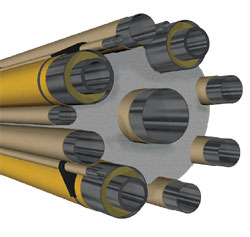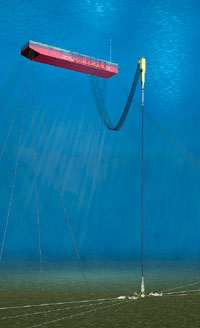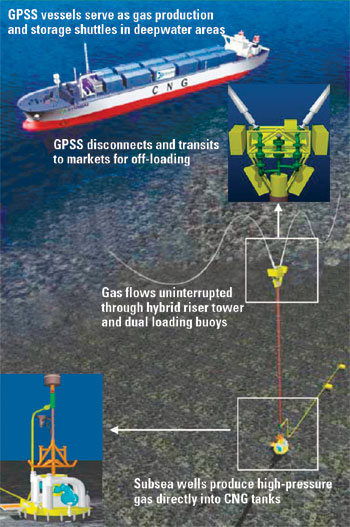Deepwater TechnologyHybrid riser tower system undergoes further developmentTested and proven in Angola, the HRT concept has been refined, with an eye toward applications in ultra-deepwater developments.Over the last several years, Stolt Offshore has developed the Hyperflow* hybrid riser tower (HRT) system into an economically competitive, technically sound solution for transferring hydrocarbons between the seabed and a floating production facility. Compared to other alternatives, such as steel catenary risers or flexible risers, the HRT system is relatively simple in design and fabrication, and has strong technical capabilities with regard to insulation. It is suitable for most deepwater offshore developments and lends itself to maximizing local country involvement in the construction process. BACKGROUND The concept of a bundled vertical riser originated in the Gulf of Mexico, where, in 1988, Placid Oil installed a riser bundle on the Green Canyon Block 29 development. In 1994, Enserch redeployed the same riser on its Garden Banks Block 388 development. Although this system is closer to drilling technology than the HRT system, the overall riser tower concept is built upon proven technology. Facing its first real test, the HRT system proved its worth at Girassol field offshore Angola, which went onstream in 2001. At Girassol, three HRTs were installed successfully in 1,400 m (4,550 ft) of water. Main drivers for operator Total’s selection of this system were critical control of fluid temperatures during transfer to processing facilities on the FPSO and layout of the field to accommodate future development. Fluid temperatures were kept above the critical degree, where wax could form inside the pipes and eventually plug the entire line, through the insulation provided by the system. In addition, during unplanned shutdown conditions, the HRT system provided enough time to implement hydrate mitigation measures. The three HRTs produced for Girassol were designed, fabricated and installed by the Alto Mar Girassol consortium, of which the vendor was the major partner. Each Girassol tower was made up from a bundle of six 8-in. riser pipes (four production and two injection) arranged around a structural core pipe, together with six additional, small-diameter gas lift and service lines, Fig. 1. The whole pipe bundle was encased with sections of syntactic foam. The foam provided both the insulation for the wellstream fluids, and the buoyancy to keep the tower vertically positioned.
TECHNICAL CONCEPT/ REFINEMENT Since the success of the HRT system in deepwater conditions at Girassol, the vendor has undertaken a significant development program to improve the concept and extend the range of conditions where it can be applied. The basic concept remains the same, with a number of riser pipes bundled together around a core pipe. These pipes are all fabricated and assembled onshore, prior to towing the riser bundle to the field. Once at the field, the riser is up-ended and connected to the seabed via a pre-installed suction anchor. The top of the tower, located at an optimum depth to minimize the effects of strong wave and current action, is connected to the floating production facilities through a series of short flexible pipes, Fig. 2.
How the system is configured to provide a competitive, technically sound riser solution will depend on requirements of the specific reservoir under consideration. Configuration will be driven by the number and size of riser pipes required, the flow assurance requirements, and any need for special features, such as chemical injection or gas lift. Advantages. As well as the obvious control of flow assurance, the use of HRT technology offers some distinct advantages over other riser concepts:
Refinement. As noted, one of the HRT concept’s primary advantages is its ability to deal with most flow assurance issues that are crucial to success in deepwater developments. These include prevention of wax and hydrates forming within the riser pipes. In the past, this has been solved with costly chemical dosage systems, something not always feasible. Accordingly, one key area on which the HRT development program has focused specifically has been flow assurance management. A group of measures to maintain required flow conditions within the production risers can now be built into the concept, as, and when, required. Alternates have been developed to the approach of combining both the insulation and buoyancy properties of the syntactic foam, which was adopted for Girassol. These include using the syntactic foam elements only for buoyancy, and applying a separate insulation coating to the individual production risers or using pipe-in-pipe products directly as part of the riser bundle. In addition, active heating can be included within the HRT cross-section design, using several available methods that include hot water or electrical heating elements. The system can, in fact, be considered as process equipment capable of controlling production fluid conditions by providing heat, gas lift, and blending fluids and chemicals. A large buoyancy tank is placed at the top of each tower deployed at Girassol to provide additional vertical buoyancy to the tower. Connection of each tank was a complex operation performed in sheltered water close to the fabrication site. This portion of the tower design has been studied as part of the program, with a number of solutions produced that simplify the connection procedure. These include a system of sliding buoyancy elements that reduces the need for the tank at the top. Other areas considered as part of the HRT development program include adaptation of the concept for applications with other floating production platforms, such as TLPs and semisubmersibles, as well as turret-moored FPSOs. These are relatively straightforward adaptations of the system, due to the inherent flexibility built into the overall concept. Extension of the concept to ultra-deepwater conditions beyond 2,000 m (6,562 ft) has also been studied, and solutions are now available for implementation. Again these are relatively straightforward extensions to the concept, as all of the materials and equipment are now proven for ultra-deep water usage.
FURTHER APPLICATION Last July, under the US federally funded Research Partnership to Secure Energy for America, and under the auspices of EnerSea Transport LLC and Kerr-McGee Oil & Gas Corp., a study was completed by Paragon Engineering Services Inc. and Advanced Production and Loading Inc. The study created a scheme for developing a generic gas field in the ultra-deep Gulf of Mexico in 8,000 ft of water, 150 mi offshore Louisiana. Study authors looked at Enersea’s Gas Production and Storage Shuttle (GPSS) technology, and determined the viability of a new concept to develop smaller gas reserves in the ultra-deep GOM. They addressed the problem of economics not always justifying construction of a fixed production facility with a tieback to existing gas pipelines. The GPSS is a medium-distance CNG transport vessel that cost-optimizes pressures and temperatures, per the distance involved. One of three riser alternatives considered was the HRT system, which was chosen because it maximizes usage of seafloor space. At the top of the HRT, a manifold directs production to one GPSS or the other, provides coiled tubing intervention access, and affords isolation (if necessary) to change a flexible riser. The proposed system includes:
The HRT is vertically placed between the loading buoys. Study authors arranged the loading buoys’ mooring lines to allow full access for umbilical replacement. Future lines and umbilicals can be added easily. |
||||||||||||||||
- Advancing offshore decarbonization through electrification of FPSOs (March 2024)
- Subsea technology- Corrosion monitoring: From failure to success (February 2024)
- Driving MPD adoption with performance-enhancing technologies (January 2024)
- Digital transformation: A breakthrough year for digitalization in the offshore sector (January 2024)
- Offshore technology: Platform design: Is the next generation of offshore platforms changing offshore energy? (December 2023)
- 2024: A policy crossroads for American offshore energy (December 2023)
- Applying ultra-deep LWD resistivity technology successfully in a SAGD operation (May 2019)
- Adoption of wireless intelligent completions advances (May 2019)
- Majors double down as takeaway crunch eases (April 2019)
- What’s new in well logging and formation evaluation (April 2019)
- Qualification of a 20,000-psi subsea BOP: A collaborative approach (February 2019)
- ConocoPhillips’ Greg Leveille sees rapid trajectory of technical advancement continuing (February 2019)





